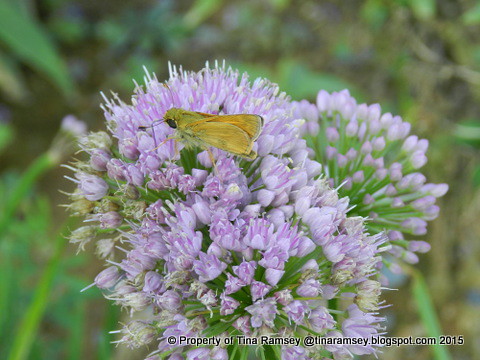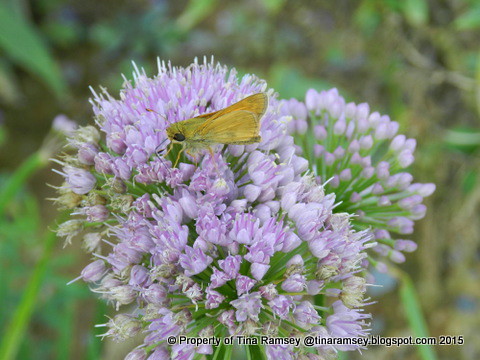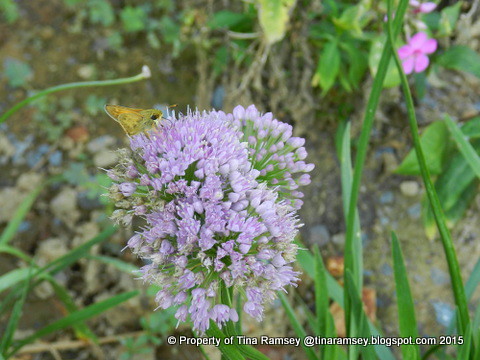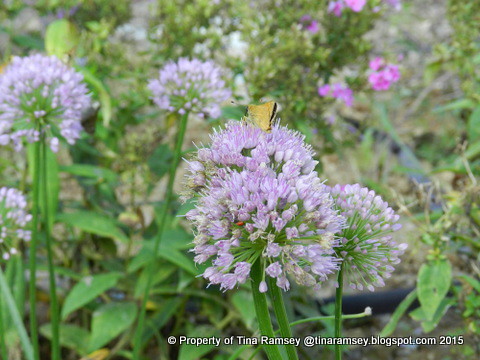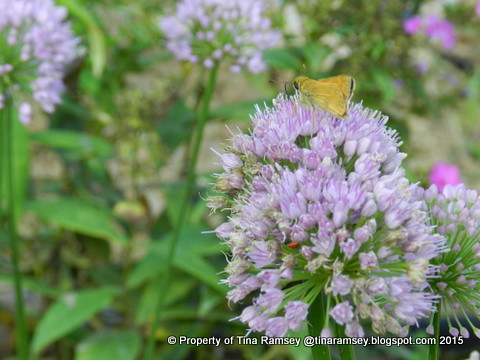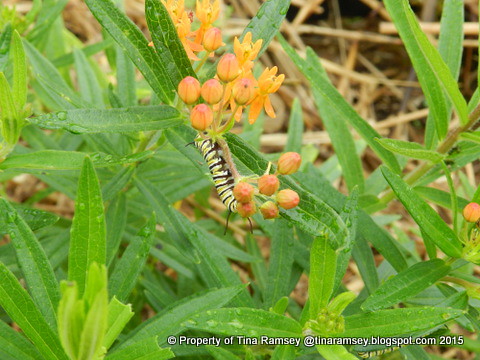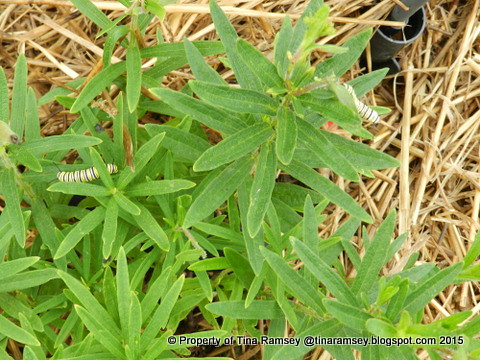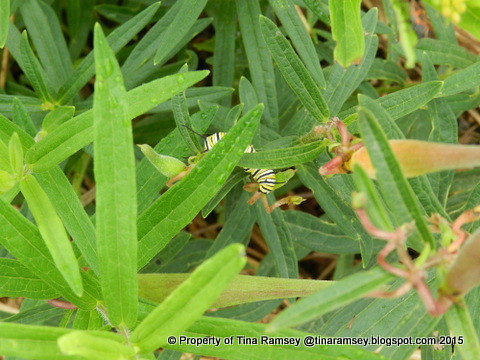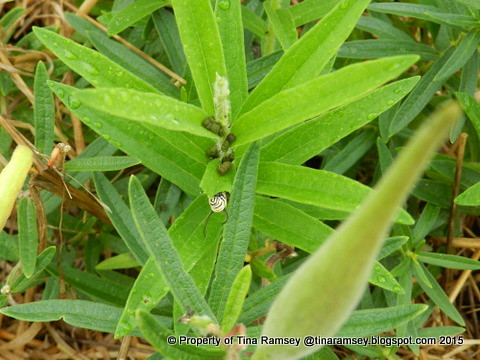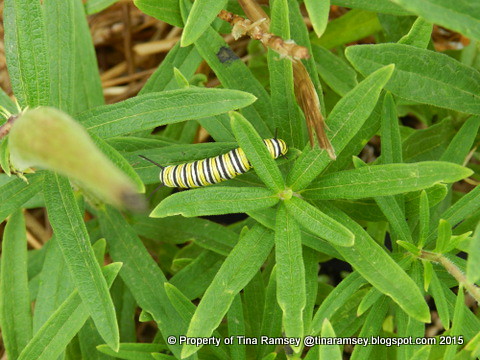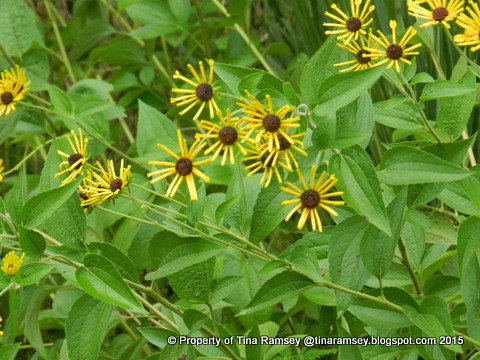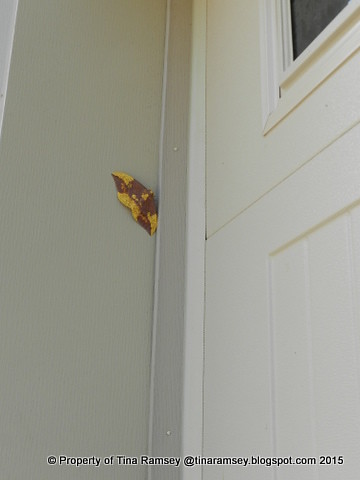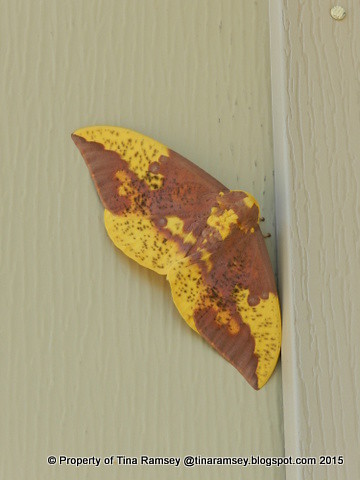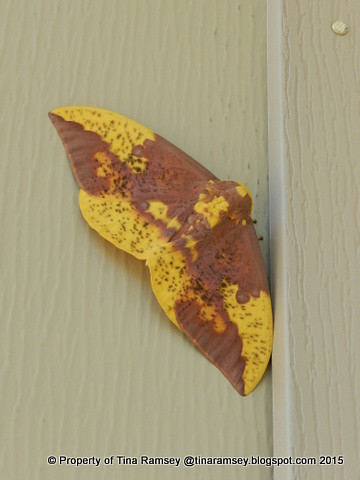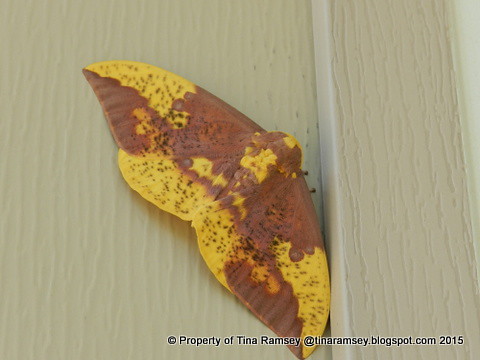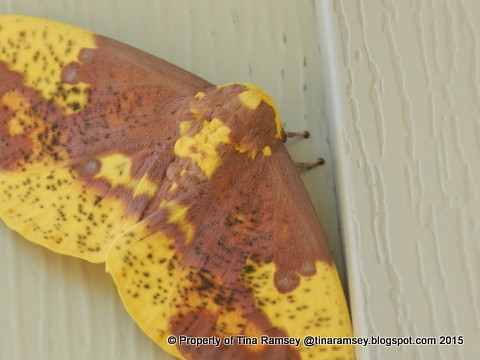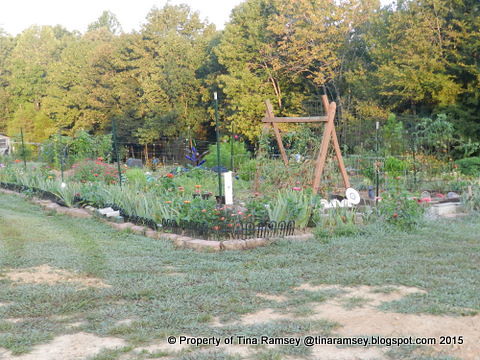
Good morning! It seems the month of August has almost gotten away from me but alas, I was able to snap pictures of the large vegetable garden just in time to get a post up. I enjoy the vegetable garden posts I do because my vegetable garden pretty much takes care of itself and is one of the easiest gardens I manage. Hence, it looks somewhat presentable most all of the time. I am slowly whipping the other gardens into shape and feel comfortable enough I will begin showing a few pictures of them too. Gardening on the new property has, like everything else in my life, been a process. Processes take time and effort and sometimes wear me out.
We start out with a long shot of the vegetable garden. Each time I take pictures I find I have a process (that word again!) and it works. Therefore, when I look back at the vegetable garden pictures they will all pretty much be in order and in a sequence. I am quite proud of my vegetable garden in that it is very neat, beautiful, functional, and the showstopper in my front yard. Yes, it is mainly my entire front yard. We had a couple of PhD students come out to Tiger Way Gardens to take samples of vegetables for a dissertation in school (TSU). I was most excited to meet the three. One was from Nepal, one was from Tanzania, and the third was from Kenya. It was exciting to meet them all especially since they were so well traveled and well rounded. They loved the vegetable garden and I think it was mainly because it was neat and organized. Organization is key to productivity I think. Just my two cents-as is everything I post.
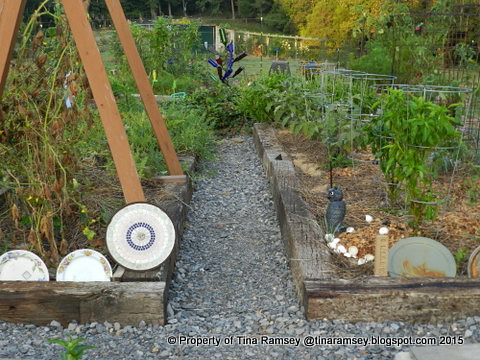
Entering the vegetable garden proper from the east end. Remember there are four large vegetable beds, one small raised herb garden, and one central raised strawberry bed. All paths are crush in run. The crush in run is a great floor for the garden. It is sturdy, packs down well, and I think it looks good. So far weeds have not been a problem in it. Every now and then one will show its ugly head in an out of the way pocket but it is usually easy to pull.

The right bed (NE) is filled with eggplants, peppers, and tomato plants. Each bed is approximately 8'x16'. I was able to fit five tomato plants, three pepper plants, and four eggplants in this bed. The tomatoes really have been a disappointment to me. I really haven't had enough for fresh eating let alone freezing or canning. We'll try again next year. The peppers are the same. The eggplants tho have really exceeded my expectations. I've had more than a dozen good sized eggplants from the four plants. This, despite gardening organically and having the plants severely attacked by flea beetles, is an ode to the hardiness of plants because my eggplants just laughed off the beetles and produced well.
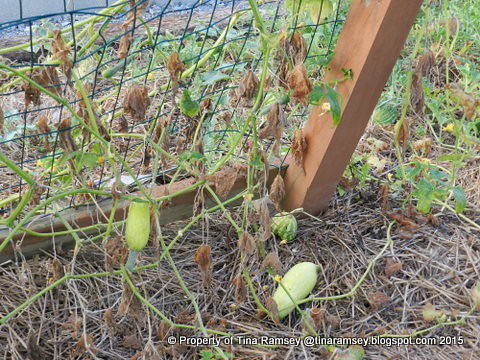
The left bed (SE) has watermelons, cucumbers, and cantaloupes growing in it. The cucumbers were all planted by seed and have produced wonderfully. Had I been on it I would've done a later planting and would still be harvesting cucumbers but life gets in the way and I did not have the time.

This watermelon is the fourth one to grow and we have several more still coming! The watermelons have been a delight. Next year tho I will plant seedless ones.
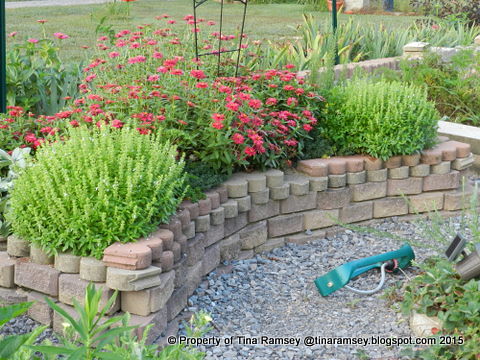
The herb garden looks and smells good! The zinnias have filled in as have all the herbs.
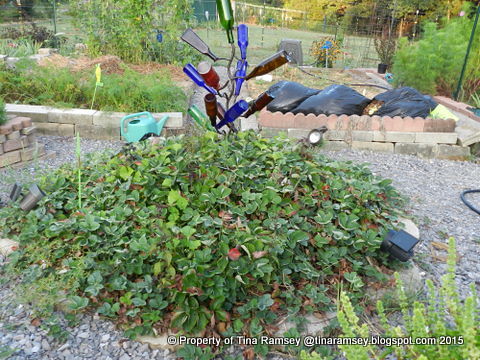
The tiered strawberry bed is something else. The strawberries are doing so well we battle it out as to who will win the gravel paths. I plan to be the victor but it is a battle to keep the strawberries in control. Despite the solid layer of plants weeds have had a chance to get a foothold in this bed. It is frustrating to me because the plants themselves are so solid I can't figure out how weeds are able to thrust their heads up to the sun. I think with time and good management practices as well as a good pre-emergent herbicide (last resort) I might be able to get the weeds under control.
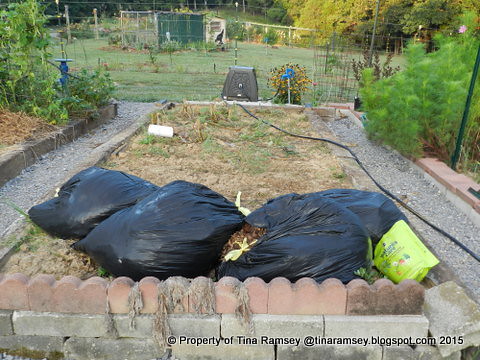
This bed (SW) had corn and zucchini squash plants growing in it. The corn produced marvelously. We enjoyed a lot of fresh corn and in fact, had so much that a good many of the ears dried on the stalks. I have since removed the stalks and tied them in bundles to be used for decorations on my outdoor gates. The zucchini died out quite a while ago thanks to squash vine borers. The black plastic bags are filled with leaf mold. I will soon be adding an organic fertilizer and turning over this bed in preparation for fall crops. The leaf mold will be topdressed as mulch and as it completely decays it will add organic matter to the soil. My soil needs organic matter in a big way.
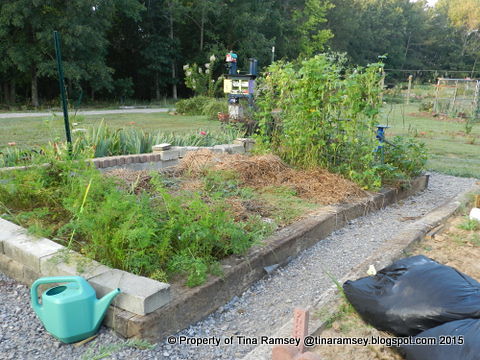
The last bed (SW) has bush beans, trellis beans, and carrots growing in it. We have harvested tons of beans and also carrots. I have actually let the carrots go too far and they are beginning to get woody but that is the gardener's fault. I enjoy the greenery and the fact the carrots are there. The chickens also enjoy the greenery when I do harvest the carrots.
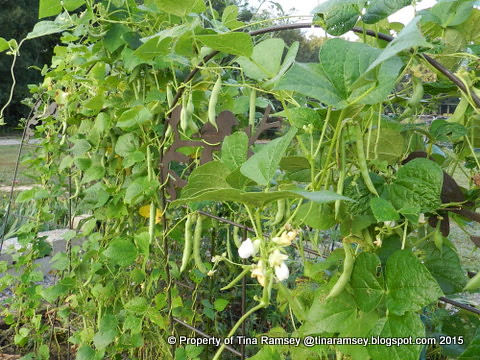
Here is an up close of the beans. The Phd student is doing a project to see how a natural bacteria will work on preventing fungi on mainly beans. She came to mainly get several samples of these plants for her project.
Next up for the garden is to seed more carrots, lettuce, and plant transplants of cool weather crops such as: broccoli, Brussels sprouts, cauliflower, and cabbage. I also need to begin planting garlic soon.
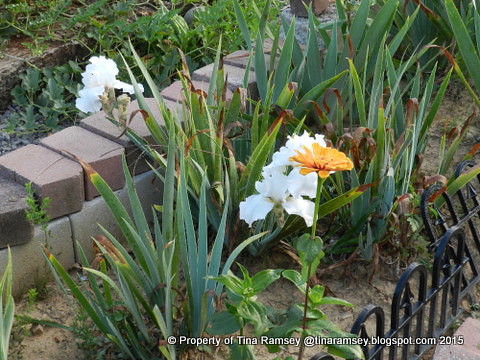
Lining the entire vegetable garden as a border is a garden containing mainly irises. This one is a reblooming iris called 'Immortality'. If you don't grow reblooming irises make it a point to add some as they are delightful in August when you get lots of blooms. This particular one smells nice.
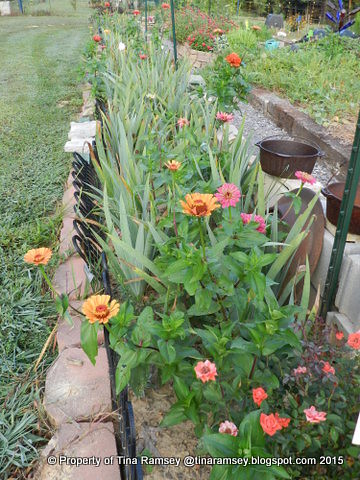
I had planted a packet of zinnias in another garden and forgot about them. Ha! All of the zinnias sprouted and were beginning to bloom. That was nice but unfortunately all of the plants were in one location approximately one square foot. I was very negligent in transplanting them. Finally, about a month ago on a rainy day I separated out all of those zinnias into over a hundred plants and moved them into the iris bed around the vegetable garden. Since you cannot mulch irises the soil in this bed is open to the air and there is pretty good circulation and full sun in this bed. It appears that all of the zinnias survived the move and are now beginning to bloom. Soon the irises will disappear and the zinnias will take over. It is my hope the zinnias will self seed and come back each year in this bed. Iris foliage is not bad to look at but the color of all the zinnias is so much nicer. This bed should become an iris bed in spring with zinnias in the summer. A perfect combination in my book.
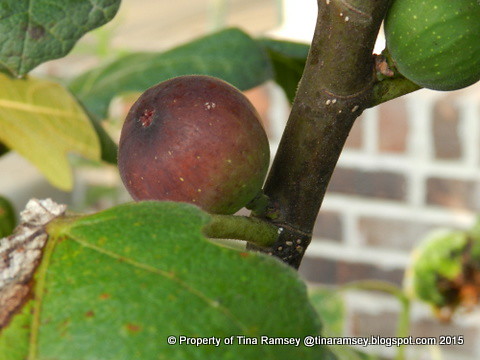
We have a few more crops coming in. The five fig trees growing in pots on the back patio are doing phenomenally well. We pick figs weekly. Have you ever eaten a fresh fig? They are very unique and good for you. I was growing the fig trees in the orchard but I lost 50% of them due to the soil being waterlogged over the winter and freezing. Placing the fig trees in pots and moving them to the garage is a much better option for me and freed up some space in the orchard for a serviceberry tree.
We also have volunteer pumpkins growing in an ornamental garden. Pumpkin vines are really a lovely plant and the large pumpkins are not bad to look at either. They should be ready just in time for Halloween. I'll show them at a later date...
in the garden....
